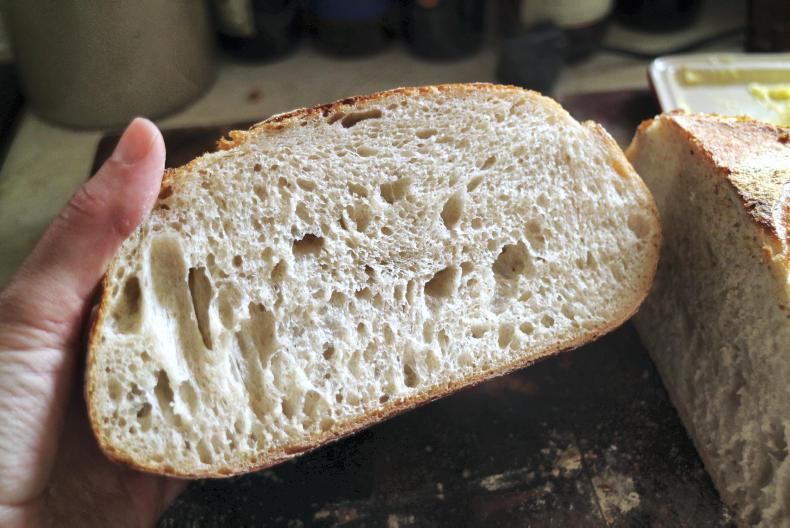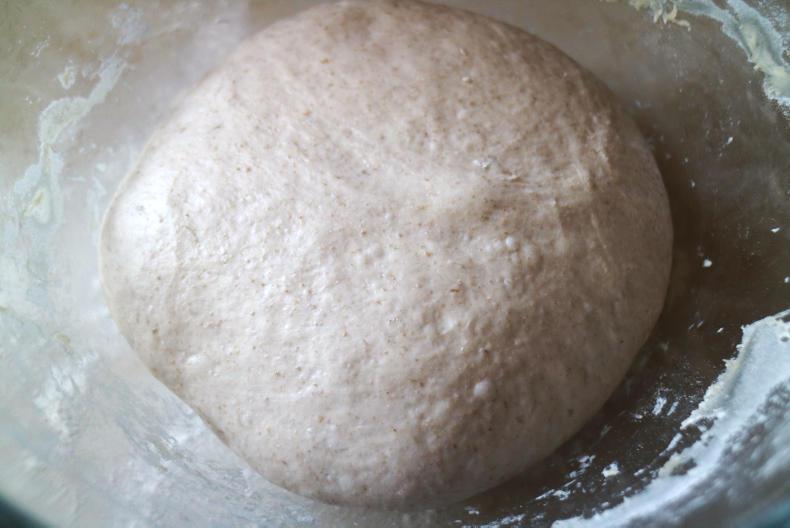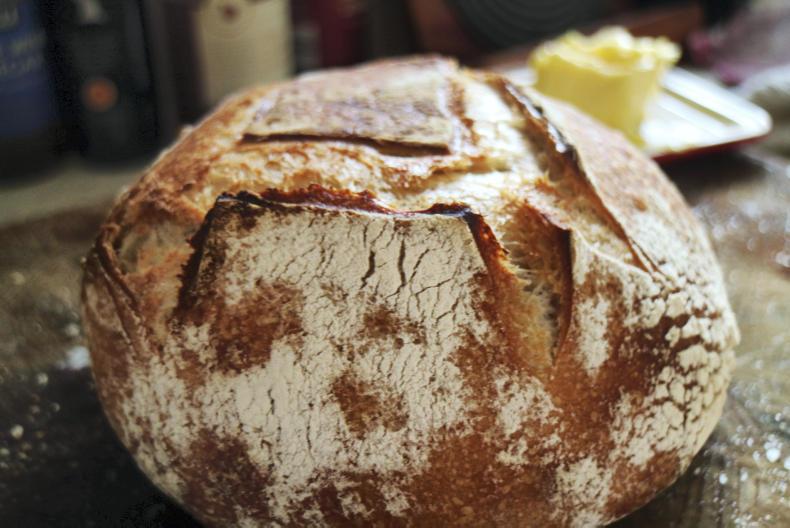Here's the thing about sourdough bread – and as a perfectionist cook, this has been a hard lesson for me to learn:
It's not always going to behave the way you want it to.
As fellow food writer Laura Brehaut of Canada‘s National Post writes in a recent article (also a great resource for beginners): “As an organic process, there are many factors that can affect the end result [of sourdough bread] — it takes practice and presence of mind to know what to do in the moment.“

This sourdough fermented overnight in the fridge and was baked in the morning.
Practise is definitely what brought me to my current level of sourdough prowess. And many failed attempts. As is common among beginners, self-doubt can be your enemy. Sourdough starter is really easy to make, but it's not like regular yeast – it needs to be fed and maintained (see the video for a how-to on sourdough starter).
In restaurant cooking, which is my background, there is always a process that has to be followed exactly. In sourdough, you follow the lead of the starter, and then the dough.
I put the dough in the fridge to ferment overnight one evening and didn't check to see if the fridge was turned on
Even after years of practise; I sometimes find myself making big mistakes. Having recently interviewed chefs Nicole Server and Bart Pawlukojc for an article , they have assured me that they also still make the odd mistake.
“I put the dough in the fridge to ferment overnight one evening and didn't check to see if the fridge was turned on," Bart laughs. “The next day I came in and realised 50 loaves had just been ruined!”
Joe Fitzmaurice of Riot Rye in Cloughjordan agrees – mistakes are just a part of the process.
“A number of years back I was making a lot of seasonal breads and so I wanted to make something like a ‘Branston‘ pickle bread for Christmas,” he says.
“Some time in September, I got some of Con Trass‘s lovely live cider vinegar and a selection of farm veg and pickled them. I had loads of orders for this Christmas special. Christmas came and I put my mix on and, about two hours later, it just tore itself apart.
There are some excellent resources out there if you‘re just starting on your sourdough journey
“The rapid change in the PH tore the gluten structure apart. Three months work to make a loaf of bread ended up in the compost, and no special Christmas loaves for Cloughjordan!”
There are some excellent resources out there if you‘re just starting on your sourdough journey. When I was a beginner I used Joe‘s “Common Loaf” tutorials to get started (and I still use this baking method as it works so well for home ovens). Patrick Ryan from Firehouse Bakery in Co Wicklow has great YouTube tutorials made with ilovecooking.ie.
The lack of flour in shops has been a problem for many bakers of late
If you're coeliac, American food blogger Aran Goyoaga has a well-tested gluten-free sourdough recipe in her cookbook Cannelle et Vanille: Nourishing, Gluten-Free Recipes for Every Meal and Mood.
Joe says if he could offer one piece of advice to someone starting out, it would be to purchase a good digital thermometre.
“Insert the probe thermometre into the loaf at the end of the bake,” he says. “If it is reading less than 90°C it's not baked. So just put the loaf back in to the oven until it is preferably reading somewhere between 93°C-96°C.”
The lack of flour in shops has been a problem for many bakers of late. There are some businesses that sell larger bags of flour and offer home delivery. In these strange times, with demand being so high, you may need to wait a while for the flour in these shops to become available or be delivered.
Kells Wholemeal has an online shop where they sell baking mixes, locally grown heritage wheat flour (limited availability) and imported bread flour. I use their Marriage‘s Finest Bread Flour for my sourdough.
Riot Rye sells four types of Shipton Mill Organic Flour; perfect for making sourdough. Due to high demand, they have stopped taking orders but will resume in mid-April.
Durrow Mills in Co Westmeath sells organic sprouted flour on their website.
Pallas Foods has opened up shop to individual customers in response to food service closures. If you create an account you can avail of their new "click and collect" service.
I usually make my sourdough starter in a glass jar; but you can use a plastic container with a lid if you like. Use weighing scales if you‘re concerned about getting the consistency correct.
It takes about a week of feeding your starter before you can make a really good loaf of bread. Here‘s my recipe (adapted from Joe‘s Common Loaf method) for one loaf of sourdough. You will need a pyrex dish with a lid (you can get one at most supermarkets for about €12).
Ingredients:
200g very active, bubbly starter
200ml room temperature water
320g strong white flour
2 tsp salt
1 Mix the starter, water and strong flour together. If the mixture seems really wet; add more flour. If it seems really dry, add a bit more water. You want to be able to handle the dough but it should be on the sticky side. 2 Leave the mixed dough in the bowl for 30 minutes; covered with a clean, damp kitchen towel. 3 Check the dough to see if it has spread – if it has, that‘s a great sign that your starter is doing its work. Add the salt at this stage (if added too early, it could kill the starter). Knead the dough lightly for about a minute on a lightly floured surface. Place back into the bowl and leave for another 30 minutes (I often get busy and don‘t time this exactly; it still works out for me). 
The dough after resting for about 30 minutes.
4 Take the dough out and stretch and fold three or four times. Shape into a ball and place back into the bowl for another 30 minute rest.5 Repeat this process three more times. On the final stretch/fold session, line the bowl part of your pyrex dish with a clean, dry dish towel or muslin cloth and generously dust with flour. Shape your dough into a ball and place, bottom-side up, in the dish. Cover and chill for at least eight to12 hours. 
The dough after being stretched and folded.
6 Preheat your oven to as high as it will go. You want it to be really hot when the bread goes in.7 Take the pyrex dish lid and sprinkle with flour. Place the lid back on the dish and flip the whole thing onto the lid. Remove the bowl and gently lift the dishcloth from the dough. 8 Score the top of the bread with a very sharp razor blade and replace the bowl of the pyrex dish so it‘s on top of the loaf; which should now be resting on the lid. 9 Place the dish in your very hot oven and bake for 30-40 minutes, until the crust is dark and the loaf has risen. Sometimes your dough looks really flat before it goes in the oven, but all of the gas bubbles in the fermented dough will expand with the heat and make the bread rise in a way you wouldn't think possible; it really is amazing.
10 Take the baked bread out and immediately remove from the pyrex dish to cool. Enjoy!
Here's the thing about sourdough bread – and as a perfectionist cook, this has been a hard lesson for me to learn:
It's not always going to behave the way you want it to.
As fellow food writer Laura Brehaut of Canada‘s National Post writes in a recent article (also a great resource for beginners): “As an organic process, there are many factors that can affect the end result [of sourdough bread] — it takes practice and presence of mind to know what to do in the moment.“

This sourdough fermented overnight in the fridge and was baked in the morning.
Practise is definitely what brought me to my current level of sourdough prowess. And many failed attempts. As is common among beginners, self-doubt can be your enemy. Sourdough starter is really easy to make, but it's not like regular yeast – it needs to be fed and maintained (see the video for a how-to on sourdough starter).
In restaurant cooking, which is my background, there is always a process that has to be followed exactly. In sourdough, you follow the lead of the starter, and then the dough.
I put the dough in the fridge to ferment overnight one evening and didn't check to see if the fridge was turned on
Even after years of practise; I sometimes find myself making big mistakes. Having recently interviewed chefs Nicole Server and Bart Pawlukojc for an article , they have assured me that they also still make the odd mistake.
“I put the dough in the fridge to ferment overnight one evening and didn't check to see if the fridge was turned on," Bart laughs. “The next day I came in and realised 50 loaves had just been ruined!”
Joe Fitzmaurice of Riot Rye in Cloughjordan agrees – mistakes are just a part of the process.
“A number of years back I was making a lot of seasonal breads and so I wanted to make something like a ‘Branston‘ pickle bread for Christmas,” he says.
“Some time in September, I got some of Con Trass‘s lovely live cider vinegar and a selection of farm veg and pickled them. I had loads of orders for this Christmas special. Christmas came and I put my mix on and, about two hours later, it just tore itself apart.
There are some excellent resources out there if you‘re just starting on your sourdough journey
“The rapid change in the PH tore the gluten structure apart. Three months work to make a loaf of bread ended up in the compost, and no special Christmas loaves for Cloughjordan!”
There are some excellent resources out there if you‘re just starting on your sourdough journey. When I was a beginner I used Joe‘s “Common Loaf” tutorials to get started (and I still use this baking method as it works so well for home ovens). Patrick Ryan from Firehouse Bakery in Co Wicklow has great YouTube tutorials made with ilovecooking.ie.
The lack of flour in shops has been a problem for many bakers of late
If you're coeliac, American food blogger Aran Goyoaga has a well-tested gluten-free sourdough recipe in her cookbook Cannelle et Vanille: Nourishing, Gluten-Free Recipes for Every Meal and Mood.
Joe says if he could offer one piece of advice to someone starting out, it would be to purchase a good digital thermometre.
“Insert the probe thermometre into the loaf at the end of the bake,” he says. “If it is reading less than 90°C it's not baked. So just put the loaf back in to the oven until it is preferably reading somewhere between 93°C-96°C.”
The lack of flour in shops has been a problem for many bakers of late. There are some businesses that sell larger bags of flour and offer home delivery. In these strange times, with demand being so high, you may need to wait a while for the flour in these shops to become available or be delivered.
Kells Wholemeal has an online shop where they sell baking mixes, locally grown heritage wheat flour (limited availability) and imported bread flour. I use their Marriage‘s Finest Bread Flour for my sourdough.
Riot Rye sells four types of Shipton Mill Organic Flour; perfect for making sourdough. Due to high demand, they have stopped taking orders but will resume in mid-April.
Durrow Mills in Co Westmeath sells organic sprouted flour on their website.
Pallas Foods has opened up shop to individual customers in response to food service closures. If you create an account you can avail of their new "click and collect" service.
I usually make my sourdough starter in a glass jar; but you can use a plastic container with a lid if you like. Use weighing scales if you‘re concerned about getting the consistency correct.
It takes about a week of feeding your starter before you can make a really good loaf of bread. Here‘s my recipe (adapted from Joe‘s Common Loaf method) for one loaf of sourdough. You will need a pyrex dish with a lid (you can get one at most supermarkets for about €12).
Ingredients:
200g very active, bubbly starter
200ml room temperature water
320g strong white flour
2 tsp salt
1 Mix the starter, water and strong flour together. If the mixture seems really wet; add more flour. If it seems really dry, add a bit more water. You want to be able to handle the dough but it should be on the sticky side. 2 Leave the mixed dough in the bowl for 30 minutes; covered with a clean, damp kitchen towel. 3 Check the dough to see if it has spread – if it has, that‘s a great sign that your starter is doing its work. Add the salt at this stage (if added too early, it could kill the starter). Knead the dough lightly for about a minute on a lightly floured surface. Place back into the bowl and leave for another 30 minutes (I often get busy and don‘t time this exactly; it still works out for me). 
The dough after resting for about 30 minutes.
4 Take the dough out and stretch and fold three or four times. Shape into a ball and place back into the bowl for another 30 minute rest.5 Repeat this process three more times. On the final stretch/fold session, line the bowl part of your pyrex dish with a clean, dry dish towel or muslin cloth and generously dust with flour. Shape your dough into a ball and place, bottom-side up, in the dish. Cover and chill for at least eight to12 hours. 
The dough after being stretched and folded.
6 Preheat your oven to as high as it will go. You want it to be really hot when the bread goes in.7 Take the pyrex dish lid and sprinkle with flour. Place the lid back on the dish and flip the whole thing onto the lid. Remove the bowl and gently lift the dishcloth from the dough. 8 Score the top of the bread with a very sharp razor blade and replace the bowl of the pyrex dish so it‘s on top of the loaf; which should now be resting on the lid. 9 Place the dish in your very hot oven and bake for 30-40 minutes, until the crust is dark and the loaf has risen. Sometimes your dough looks really flat before it goes in the oven, but all of the gas bubbles in the fermented dough will expand with the heat and make the bread rise in a way you wouldn't think possible; it really is amazing.
10 Take the baked bread out and immediately remove from the pyrex dish to cool. Enjoy! 








 This is a subscriber-only article
This is a subscriber-only article









SHARING OPTIONS: